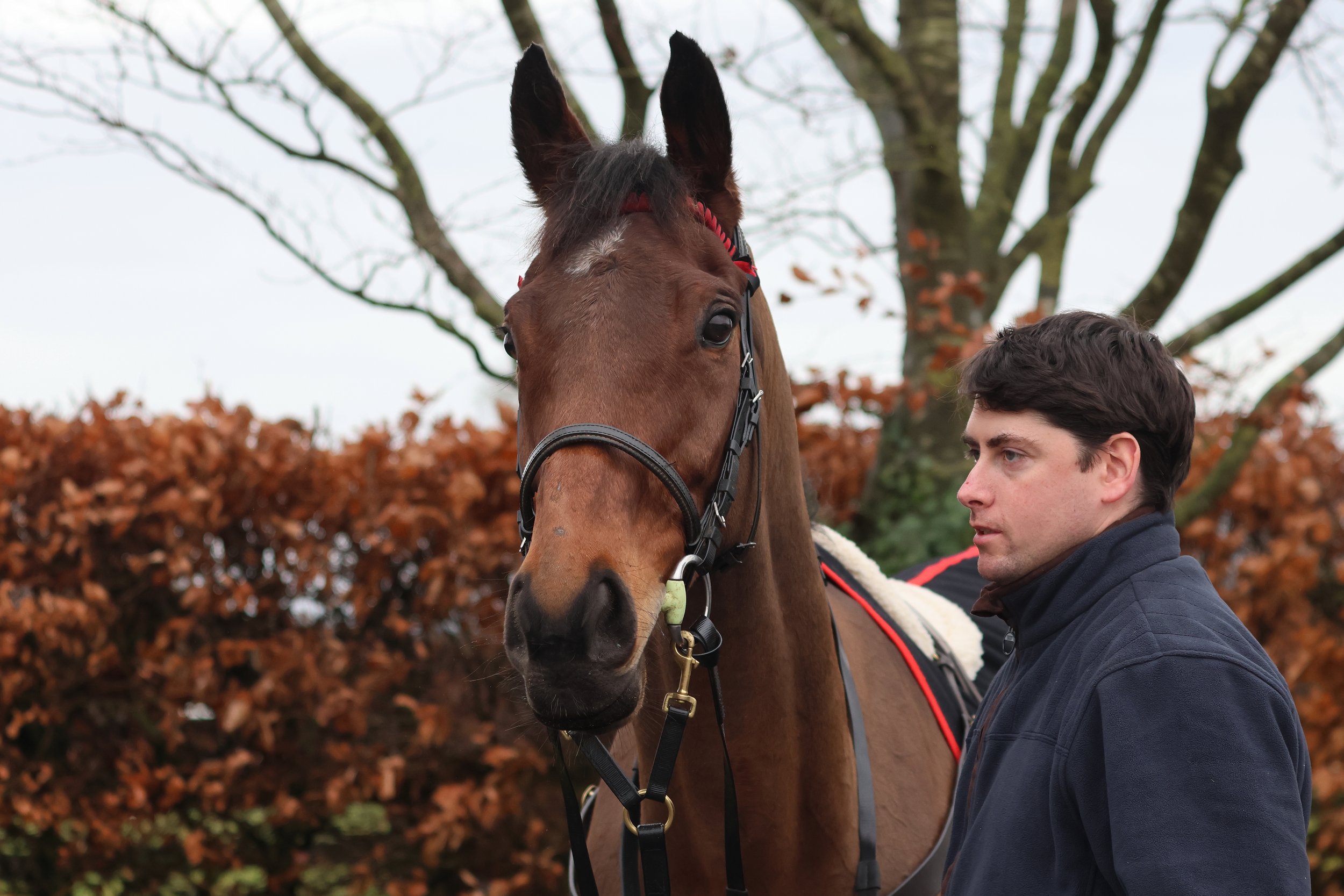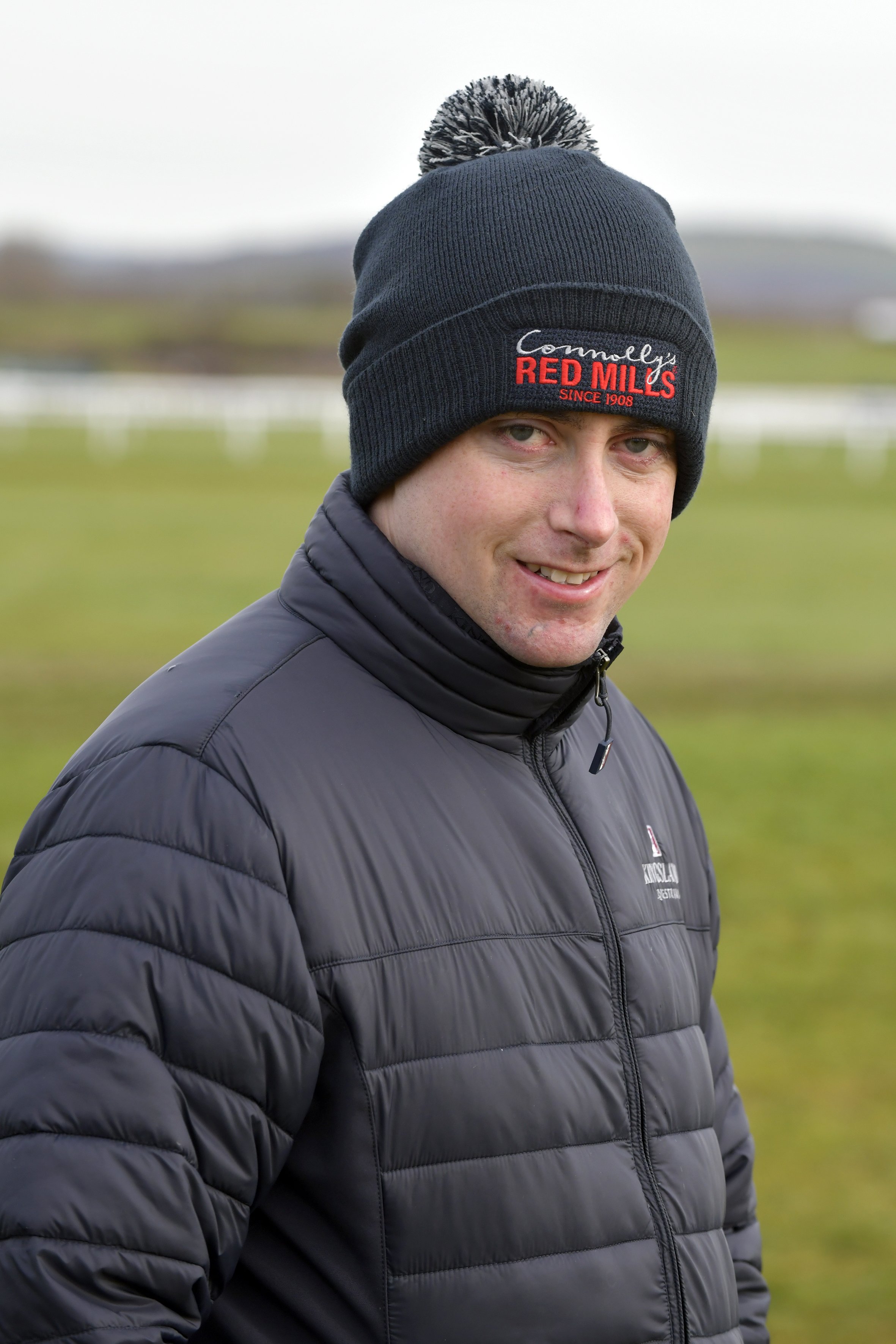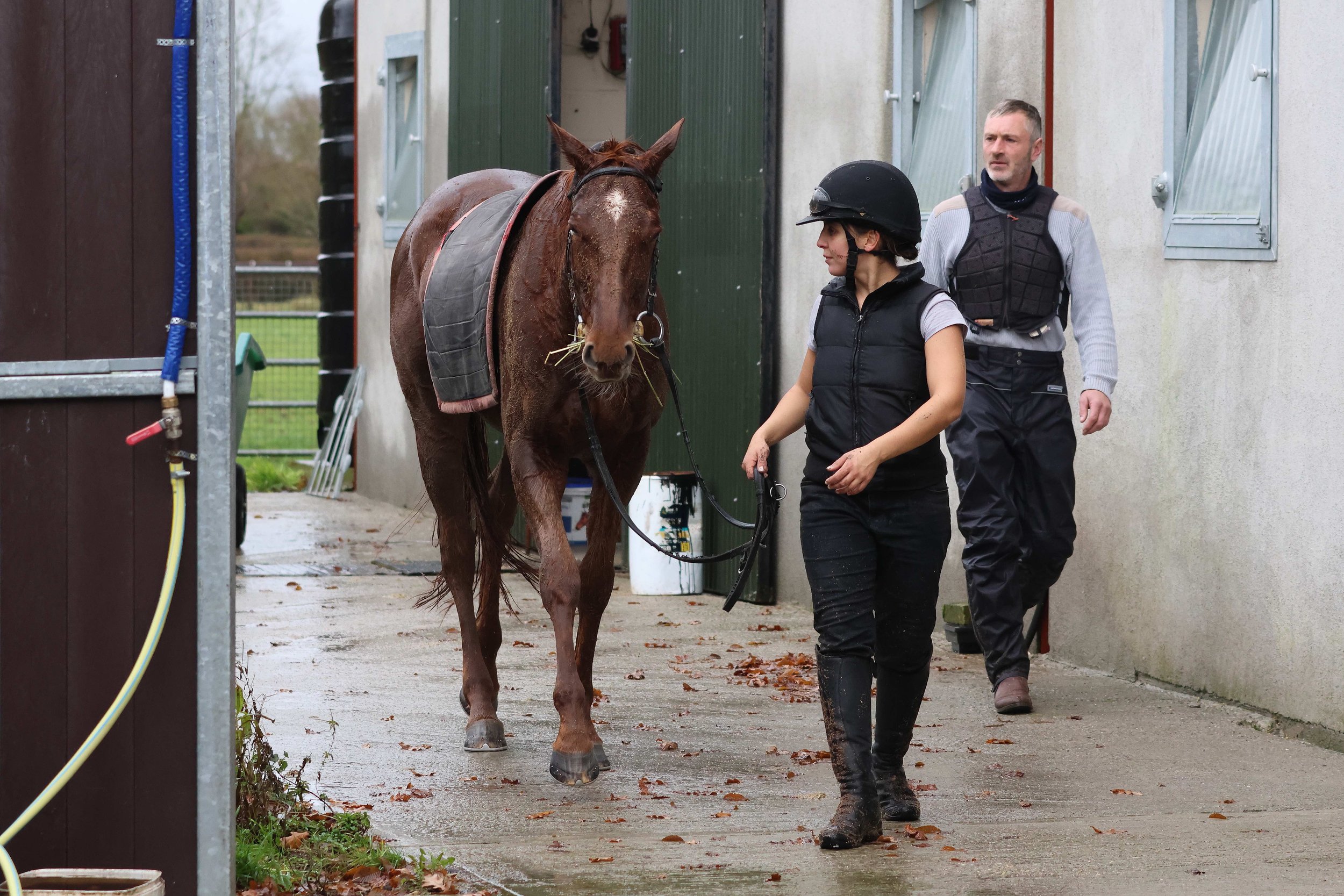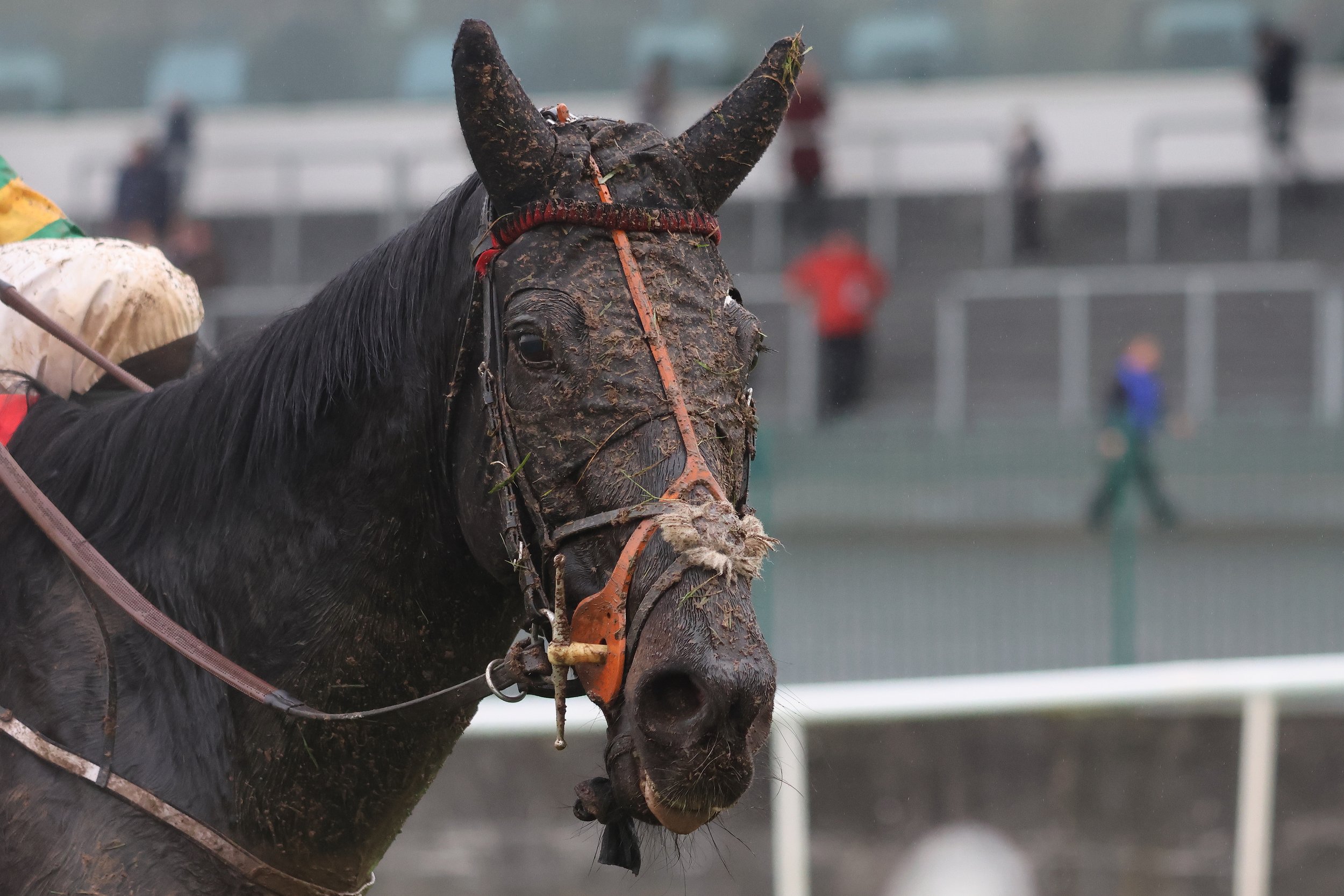Point-to-Point racing and its role in developing jumpers
/Article by Daragh Ó Conchúir
There has always been something special about a well organised point-to-point.
It is social, in the truest sense. A communal gathering of like-minded people, with a love of rural pursuits and lifestyle.
It is racing at its purest too, founded on the genesis of steeplechasing in the Irish county of Cork in 1752. That was when Edmund Blake and Cornelius O’Callaghan chose to resolve which of them possessed the best steed by racing the four and a half miles from Buttevant Church to its Doneraile counterpart. Steeple to steeple, taking whatever route they saw fit and clearing whatever obstacle was in the way. Naturally, the money was down to increase the stakes.
Good horses often emerged from this sphere, with Tom Costello a legendary source of Gold Cup winners, but that wasn’t the raison d’être. Pointing was a leisurely pursuit. There was no competition for National Hunt trainers when it came to the acquisition of stores or younger jumping stock.
The landscape began to change with the introduction of an autumn point-to-point season by Irish authorities to make up for the fixtures lost by the outbreak of Foot And Mouth in 2001 but the last decade has seen an increasing commercialism that has altered the face not just of point-to-pointing, but of racing under Rules.
This has only accelerated by the reduction in availability of the good Flat handicappers, now flowing to jurisdictions such as Hong Kong and Australia with mammoth prize money justifying the eye-watering sums that National Hunt people could not justify.
There is always a risk with buying thoroughbreds but for end users, that is alleviated somewhat when there is form with proven depth. Of course there is a premium on that.
The results speak for themselves when it comes to the question of whether or not the sector is developing jumpers to a requisite level. Just look at the recently concluded Cheltenham Festival, where of the 27 races, nine were won by graduates of the point-to-point circuit – eight from Ireland and one from Britain. That latter success was in the point-to-point feature, the Foxhunter Chase, as Sine Nomine repelled the strong raiding challenge for Fiona Needham, her father Robin Tate and jockey John Dawson.
What is notable though is the high level of achievement. Of the other eight graduates from the point scene to score, five did so in Grade 1s: Slade Steel (Supreme Novices’ Hurdle), Ballyburn (Gallagher Novices’ Hurdle), Fact To File (Brown Advisory Novices’ Chase), Jasmin De Vaux (Champion Bumper) and Stellar Story (Albert Bartlett Novices’ Hurdle). There was a clean sweep of placings by ex-pointers in the Brown Advisory and Albert Bartlett.
This is not anything like a one-off, of course. When Colin McKeever’s Loughanmore winner, Ballyburn, sauntered to a 13-length triumph in the Gallagher, he was the fourth alumnus of the sphere to land the spoils in that particular Grade 1 in five seasons. Slade Steel was the fourth to bag the Supreme in the same period. That’s Constitution Hill, Shishkin, Envoi Allen and Bob Olinger we’re talking about between the two.
There is depth in terms of the handlers producing these talents also. Donnchadh Doyle, whose brothers Seán and Cormac are established providers with the likes of Monkfish, Holywell and Bravemansgame included on the roll of honour, was the only provider to have multiple winners, having guided Fact To File and Stellar Story to successes at Bellharbour and Castlelands.
Apart from the aforementioned McKeever, Pierce Power, Colin Bowe, Euguene O’Sullivan, Stuart Crawford and Warren Ewing had the satisfaction of seeing former charges deliver on the biggest stage.
It is significant too that the octet won their maidens at eight different venues, illustrating the calibre of the tracks.
The growth in the sector and the unarguable evidence that this system is working is seen in figures provided by Irish point-to-point website, p2p.ie. If we take the past 15 completed jumps season from 2008/09 to 2022/2023, we see a progression from when graduates won 725 track races, eight of which were at Grade 1 level, to a stunning 1570 winners and 27 elite successes. The total number of black-type winners increases from 39 to 98.
Since 2015/16, the number of winners has only dropped below 1400 once, and that was in the Covid-impacted 2019/2020 term.
While the number of winners has largely been consistent – 1718 in 2020/21 was a high-water mark – the quality continues on an upward climb, with 27 Grade 1s secured by Irish point products in two of the last three seasons with completed figures.
And that is why the prices continue to rise. The record for the most expensive point-to-pointer was set in November 2020, when JP McManus shelled out £570,000 for Jonbon at the Goffs UK Sale in Yorton after the full-brother to multiple Grade 1 winner Douvan had cantered to a 15-length triumph for Ellmarie Holden, Paul Holden and Michael Shefflin.
At the Punchestown Festival Sale 12 months ago, it was a mare that attracted the biggest bonanza, as Mags O’Toole spent €500,000 on behalf of Brian Acheson’s Robcour ownership banner for Qualimita, who had dotted up in a Fairyhouse maiden by 30 lengths for Walter Connors and Bowe.
A highest price for a British filly pointer was set last May, when Saunton Surf was sold in May for £175,000 by Brad Gibbs to Warren Greatrex at the Goffs Spring Sale in Doncaster.
That was matched last December, as Just A Rose was bought by Tom Malone, for British champion trainer Paul Nicholls, from Tom Ellis and breeders Sarah and Nigel Faulks. The same buying combination snapped up Will Biddick’s facile Badbury Rings victor, No Drama This End for £160,000 at the Cheltenham Festival Sale in March.
Meanwhile, Eddie O’Leary signed a chit for €265,000 at the Tattersalls Ireland Derby Sale last June for a store that was heading in Gordon Elliott’s direction and in all, 33 horses sold for €100,000 or more at that auction, making it the third best result in Derby Sale history.
And remember, a Camelot half-brother to Altior realised a staggering €155,000 at the Tattersalls National Hunt Sale in November 2019, purchased by former Republic of Ireland soccer international Kevin Doyle from Coole House Farm on behalf of Paddy Behan Jnr. It was the highest price paid for a foal at the sale for 12 years and the third highest in its history.
While the most recent auctions might finally be suggesting a slight correction, Irish producer and trainer, Liz Doyle wasn’t far wrong when she described the point-to-point sector as ‘pandemic and recession-proof’.
Jerry McGrath is relatively new to the scene as a bloodstock agent, a role he took up upon his injury-enforced retirement at the beginning of 2022. But the Cork native had long been tasked by his boss Nicky Henderson with keeping an eye on the Irish point-to-point circuit during his time at Seven Barrows, during which he rode two Cheltenham Festival winners.
Love Envoi provided him with his first Cheltenham triumph as a buyer. Jango Baie is a Grade 1-winning novice hurdler this year and Jingko Blue is another youngster acquired from racing through the flags that has made a good transition to the track.
“It’s been well documented; it’s harder to get hold of these highly rated, staying flat horses now because there’s such a market for them abroad,” says McGrath. “Because that has happened it has narrowed where you get your jump horses from and I think that’s why maybe the point-to-point thing has come so strong.
“Of course, it has been massively influenced by the point-to-point handlers themselves. I have the utmost respect for those lads. They go out there, they put their money on the line, they invest in horses that they like at the store sales. We’ve seen in the last three or four years, they’ve been outbidding plenty of trainers.
“When you look at it like that, it sounds a bit bonkers that the point-to-point men are outbidding the end users, bearing in mind they have to prove the horse’s ability, with the hope that the end user comes back and buys it as a winning point-to-pointer.”
This is why not every trainer is a fan, as they are now priced out of the market at both potential entry points –sales for stores and pointers. But in an open market, those willing to risk the most, make the most. The vital element to it all is the emergence of talented animals on a consistent basis.
The handlers are clearly discerning in their sourcing too. While there are fashionable stallions, the point graduates that delivered at Cheltenham came from a variety of sires: Flemensfirth (Ballyburn), Shantou (Stellar Story), Poliglote (Fact To File), Telescope (Slade Steel) and Tirwanako (Jasmin De Vaux) were the Grade 1 performers, while Gamut (Corbetts Cross), Milan (Better Days Ahead) and Saint Des Saints, whose three winners at the festival included Sine Nomine, completed the crop.
This is why McGrath’s priority is the model rather than the page, although pedigree has to be taken into account.
“You can have a potential superstar but if he’s a terrible mover, his longevity is going to be very short. It’s a bit like cheap speed, the two-year-old that’s going out very early. You might win a two-year-old maiden at the start of the year but will you be there at the end of the season competing in group races? Probably not. So you do have to have an athletic horse.
“Temperament definitely comes into it but at the same time, these are young horses, and their temperament can be managed, especially if they go into the right hands. If you’ve got a hot and buzzy horse, it doesn’t mean they’ll be hot and buzzy in two years’ time.
“Athleticism and movement is the big thing for me. And you have to have a bit of pedigree. If they’re not bred to be a good racehorse, why would you be surprised they’re not a good racehorse?”
Pat Doyle is one of the enduring characters of the Irish point-to-point sector, having been among the pioneers for using it to sell four and five-year-olds with form before the likes of the Wexford crew of Bowe, Denis Murphy and the unrelated Doyle brothers raised the bar. He kept up with the evolution though and had at least ten graduates running at Cheltenham. The majority of them were trained by Mullins, which is no mean imprimatur.
It is 50 years this year since Doyle broke future dual Champion Hurdle winner Monksfield as a two-year-old. Later on, he pre-trained Minnehoma for his good friend Roddy O’Byrne to sell. Minnehoma followed Cheltenham success with a famous Grand National victory in 1994.
Bob Olinger, Appreciate It, First Lieutenant, Shattered Love, Colreevy, Readin Tommy Wrong, Bacardys, Commander Of Fleet, Champ Kiely and Brindisi Breeze are just some of the other Grade 1 and Cheltenham winners to have emerged from his academy.
The very latest off the production line, Ballycahane winner In The Age, sold at the Cheltenham Festival Sale for £100,000 to Ryan Mahon for the leading British trainer at the festival, Dan Skelton. The headline act at this boutique offering was the purchase of Echoing Silence by Peter Molony from Sam Curling and Correna Bowe for £410,000, to be trained by Henry de Bromhead.
This sale has produced the last two Gold Cup runners-up, Bravemansgame and Gerri Colombe, while three of its graduates from the 2023 sale participated in the Champion Bumper this March, including the runner-up Romeo Coolio and third-placed Jalon D’Oudairies.
“The biggest trick is selling them to good trainers,” Doyle relates. “I’ve been very, very lucky with Willie Mullins, Henry de Bromhead and fellas like that buying horses off me that turned out to be successful. I’m an open market for anyone to buy horses off but Willie Mullins (had) seven or eight horses I sold him running at Cheltenham.”
For a long time, Doyle and his fellow Irish handlers had this niche to themselves. The likes of Sophie and Tom Lacey were trading but the point-to-point arena remained Corinthian in spirit and action.
The old traditions are gradually being cast off with the likes of Gold Cup runner-up Santini (Ed and Polly Walker) and Ahoy Senor (Melanie and Philip Rowley) having emerged and with handlers of the calibre of Tom Ellis and Gina Andrews, Bradley Gibbs, Fran and Charlie Poste, Josh Newman and Kayley Woollacott and Will Biddick in the vanguard of those guiding young talent.
Tom Lacey is now training under Rules, but having produced dual Champion Chase winner Energumene, Sebastapol (this pair won two divisions of the same open maiden at Larkhill in January 2018), Blackbow, Kimberlite Candy and the most expensive British pointer ever Interconnected (sold for £220,000 after winning at Larkhill in a month after Energumene and Sebastapol), remains an ardent advocate of the division on his native shore.
“I think it’s irreplaceable. I don’t believe there’s any better grounding for jumps horses than point-to-points,” Lacey states definitively.
“Ten years ago you could send a well-educated horse 80 per cent fit to an English point-to-point and you’d win it stylishly. Now you need to be well educated and be a 100% fit. There’s plenty of depth there now. There’s more and more people doing it and you’ve got plenty of good, sharp lads doing it.
“I think there’s still an element where the British point-to-point programme needs to be tweaked… For example, this is the time where your four-year-olds start coming to fruition. You know where you are with them, you’re ready to run and this weekend they’ve got a five-year-old and over maiden point-to-point. Well that’s just stupid.
“They have also introduced these point-to-point Flat races. The issue I have with those is they have diluted the maidens. They have taken away a lot of the young horses which would traditionally have run in a point-to-point. And now the people that don’t want to be commercial fiddle around for a season running around in these point-to-point Flat races and to be quite honest with you, they’re dirt. You won’t sell a horse out of one of them. They should never have been allowed to come in.”
Does it damage the reputation of the product?
“Yes it does. All of the boys operating on a commercial basis won’t entertain them. If you want to sell a horse, it needs to be able to jump 16 or 18 fences and do it nicely.”
McGrath has plenty of praise for the British scene.
“There is talent emerging and we’d love for it to be stronger again but sometimes, people struggle to get a grasp on the English form, whereas a lot of people know the Irish point-to-point handlers better, they know the tracks better and can get a better handle on the form but at the same time, it doesn’t mean that there’s not lots of good horses come out of English point-to-points.
“I think sometimes there can be a bit of value and when you are buying pointers, it is important to remember that it is budget driven and you don’t always have to shell out the big numbers to buy a good horse.”
Lacey and Doyle are in agreement about the importance of producing a racehorse over a sales horse. It is the only way to ensure longevity as a commercial entity.
“There’s no point trying to sell a mediocre horse for a lot of money ‘cos you’ll only ever do it once,” Lacey declares. “We had a horse won at Dingley Point-To-Point (by 16 lengths) called Space Safari. Bryan Drew was there that day and rang me up that evening and said, ‘What do you want for that horse?’ I said, ‘Bryan, I can’t sell him to you. Don’t ask me any more questions but I can’t sell him to you.’ And that was because I wanted him to come back and buy another one.”
“I don’t want to sell a bad horse,” is the Doyle mantra. “I had a few horses in Cheltenham at the (February) sale. They made good store prices, but I explained to the guys that bought them, ‘This is what these horses are capable of doing. They’re good horses. Are they Saturday horses? Maybe not, but they’ll win races.’”
When a vendor is known for this sort of honesty, buyers take note when he vouches for a horse. Doyle’s word was enough for Willie Mullins to acquire Appreciate It, Champ Kiely and Readin Tommy Wrong despite them failing to win their maidens but they are all Grade 1 victors now.
And of course, Nicky Henderson bought Constitution Hill because of his respect for Warren Ewing and his former No 1 jockey Barry Geraghty, who had sold him future Gold Cup winner, Bobs Worth. Constitution Hill finished second in his point at Tipperary, after making a terrible mistake at the last. What’s more, the physical exertions left a toll. It was only the word of men he knew and trusted that maintained Henderson’s interest. As we know, the Blue Bresil seven-year-old has yet to lose a race on the track and sauntered to a Champion Hurdle success last year before illness ruled him out this time around.
Some horses are just slower developers. Grand National winner Corach Rambler, who ran a stormer to be third in the Gold Cup and is a short price to back up his Aintree heroics, took five attempts to win a point for John Walsh, finally getting his head in front in a six-year-old’s and older maiden at Monksgrange in September 2020. So a relationship and trust with the vendor is critical.
“A very good example was Love Envoi,” McGrath explains. “She didn’t show herself very well on the day and there was a minor vetting issue but Seán (Doyle) assured me it had not stopped her and it would have surprised him if it ever did cause an issue. We paid thirty-eight grand for her and she turned out to be a Cheltenham Festival winner, a multiple black-type filly and a Grade 1-placed filly. That was a perfect example of trust.”
It is noteworthy how often Mullins’ name crops up in the course of these discussions, reflective perhaps of his dominance. What is interesting is how often he gets his business done privately, via his agent, Harold Kirk, with Pierre Boulard his man on the ground in France when it comes to acquiring the talent emerging from French three and four-year-old hurdles. Lacey is adamant that this, more than anything else, is why he is the leviathan of jump racing.
“People say, ‘What’s Willie Mullins doing that allows him to get all these best horses?’”, the Cottage Field Stables conditioner begins.
“If you’ve got a good horse and you genuinely believe it’s a graded horse, if you ring Harold Kirk and say, ‘Harold, I’ve got one for you,’ he will say, ‘What do you want for it?’ You’ll name your price and he will say, ‘I’ll have it.’
“That is what Willie Mullins does differently. He doesn’t say, ‘I’ll come back to you in a week’s time.’ The vet’s there within the week and they just get the business done. They do not sit on the fence and allow horses to be sold from underneath them. That is one of the things he does that no one else does. They are so straightforward.
“He’s got Harold Kirk working from November onwards with all the point-to-point handlers working in Ireland, with the point-to-point handlers in England. He used to come over and see all mine before Christmas, see which ones he liked, asked me which ones I liked and if they did what I expected them to do, I rang him up and said, ‘Harold, you should buy that horse.’
“‘I’ll have it.’
“That’s what Willie Mullins does that no one else does.”
Horse Racing Ireland has intimated a willingness to develop a programme of bumpers and hurdles for three-year-old store horses, while there is a programme of junior NH hurdles in Britain, though for paltry prize money.
This comes on the back of the success of the French programme of three-year-old hurdles that is backed with significant prize money by France Galop and is producing major talent. The first of the year was held at Compiegne on March 5, with the connections of Willie De Houelle landing €27,140 for a four-length triumph, the total prize fund amounting to €59,000.
The Beaumec De Houellle gelding is trained by Arnaud Chaille-Chaille, who also was responsible for the sire winning at Grade 1 level. His best graduate, however, is Galopin Des Champs, who won a four-year-old hurdle at Auteuil on debut before relocating to Ireland and becoming a two-time Gold Cup hero.
McGrath has a number of Gallic contacts and sourced the highly promising juvenile, Sir Gino for Henderson from an April maiden at Auteuil. He is a huge fan of a system that also produced the new Champion Hurdler, State Man.
Doyle has reservations about racing moving in this direction though concedes that he would get involved in two-year-old sales if they were to come on stream.
For his part, Lacey believes that this method, while suitable to French-breds, is not necessarily transferable.
“I’d be very old school,” says Lacey. “I think we are all expecting too much too soon from a lot of these young horses. The powers that be want us to follow the French model with Irish pedigrees. We’re breaking a lot of horses at two, turning them away, bringing them back at three and turning them away. They’re still not ready. I don’t know if it’s the breed or the way we produce them or the way we train them or what, but our horses just don’t come to hand like they do in France.”
And you have to do right by the horse.
“Course you have. But when Energumene was here, the ease with which he did everything was astonishing. The gulf between a good horse and a Grade 1 horse is vast. You see it on the gallops, it just floats everywhere. Everything is so effortless.”
He jokes that he had to buy a lot of stores to find that Grade 1 winner – to be fair, Energumene is a six-time Grade 1 winner – but that is the role the handlers play, taking on risk, filtering the wheat from the chaff.
“They go out, they put their own money on the line, they buy these horses as three-year-olds, they take all the risk. They break them. They canter, they school, they gallop the horses, they run the horses in a short space of time. Ideally they like to sell them as four-year-olds, sometimes they carry over till they’re five-year-olds. The good ones go on and make a lot of money and a profit, but there’s an awful lot of horses don’t even see the track, they don’t make the grade. And there’s plenty ones aren’t as good as they want them to be and if they’re lucky, they wipe their faces with them. That’s why they need the big priced ones because they’re covering the cost of the ones we don’t see or hear about.”
High risk, high reward, providing the ultimate quality control service.
Still special.


































